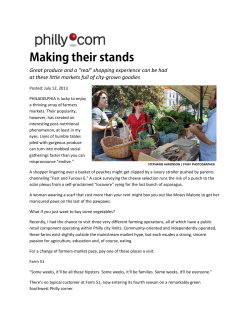
Proceedings of the 17
th Proceedings of the 17 Physics of Estuaries and Coastal Seas (PECS) conference, Porto de Galinhas, Pernambuco, Brazil, 19–24 October 2014 Estuarine Dynamics in Climate Change Scenarios: Santos Estuary, SP FIEDLER, M.F.M.1, SIEGLE, E. 2 1 Tetra Tech, São Paulo, Brazil/ Laboratório de Dinâmica Costeira, Instituto Oceanográfico, Universidade de São Paulo, Brazil. Email: fernanda.fiedler@tetratech.com/ mfmfiedler@usp.br 2 Laboratório de Dinâmica Costeira, Instituto Oceanográfico, Universidade de São Paulo (USP), Brazil. Email: esiegle@usp.br Keywords: Santos Estuary, Delft3D, Climate Change. SUMMARY A Delft3D hydrodynamic model was implemented to simulate the Santos Estuary dynamics, which is located in São Paulo State/ Brazil. At the boundaries, a so-called Riemann boundary condition is imposed. In this type of boundary, currents and elevation results from HYCOM global model in composition with a global tide model (TPXO) results are used. The model is evaluated through the comparison of its results with collected current and tide data. Based on the validated model configuration, three different scenarios were tested considering sea level rise (defined according to IPCC projections). The velocity is compared between the scenarios in the main channels that belong to the estuarine region. One of the channels presents increased velocities whereas the others presented lower velocities considering the sea level rise. 1. INTRODUCTION Sea level rise is one the main issues in climate change research and the estimation of coastal changes due to sea level rise is been researched for future shoreline management. It is been expected increasing occurrence of flooding, saltwater intrusion and erosion causing coastline retreat (CHINI et al., 2010; NICHOLLS & CAZENAVE, 2010). According to [1] ALFREDINI et al. (2007) for the Southeastern and Southern regions of Brazil, a small increase in the relative sea level would be enough to cause changes in the salt marshes zones, mangroves and transition bands of barrier beach, besides changes in currents and freshwater in estuaries. The present study has the target to identify possible impacts of a sea level rise on Santos Estuary. The Estuarine System of Santos is located in São Paulo State, Southeastern Brazilian Coast. The system consists of three major estuarine channels and is an area of intense urban, industrial and port activity (MOSER et al., 2005 [5]). It holds the main Brazilian Port, which is the largest commercial harbor in Latin America. 1. METHODS With the aim of better understanding the Santos Estuary dynamics, Delft3D-FLOW hydrodynamic model from [3] DELTARES (2013) was implemented to simulate the elevation and currents field in Santos region, São Paulo State/ Brazil. On Delft3D-FLOW numerical model the system of equations consists of the horizontal momentum equations, a continuity equation and a turbulence closure model. The vertical momentum equation is reduced to the hydrostatic pressure relation as vertical accelerations are assumed to be small compared to gravitational acceleration. The model equations are solved by applying sigma layering in the vertical and in this study the model runs in the 3D mode (DELTARES, 2013 [3]). In order to capture the continental shelf dynamics but also represent the detailed estuary region, the computational domain was decomposed into four (4) hydrodynamic grids on Delft3D. Three domains (1, 2 and 3) run online using domain decomposition technique (DD-boundaries) where the computations are carried out concurrently - parallel computing. The last domain (4) runs using the nesting technique th Proceedings of the 17 Physics of Estuaries and Coastal Seas (PECS) conference, Porto de Galinhas, Pernambuco, Brazil, 19–24 October 2014 (Figure 1). This procedure consists on a list of monitoring stations in the overall model (grid 3) in which the results are saved. Based on these results, the boundaries for the fourth grid are generated by the program. Figure 1: Domains running on Delft3D. As boundary conditions, the model uses a composition between harmonic constituents, extracted from TPXO global model, and HYCOM Global1’s currents and elevation results (1/12° resolution) imposed at the boundaries as Riemann condition. Using this type of boundary condition the outgoing waves are allowed to cross the open boundary without being reflected back into the computational domain (VERBOOM & SLOB, 1984 [7]; DELTARES, 2013 [3]). HYCOM results enable Delft3D to incorporate low frequency signs that may be associated with cold fronts, which can cause a considerable increase on the sea level height. Additionally, average monthly discharges were added to the hydrodynamic model, predicted for sixty-five rivers located nearby Santos Estuary. From the validated model, sea level rise scenarios have been simulated. The scenarios were defined from the IPCC (2007) projections giving the following scenarios: 1st Scenario - sea level rise considering the rate from XX century2; 2nd Scenario - sea level rise considering the rate from XX century adding 2 mm/year acceleration3; 3rd Scenario - sea level rise considering the rate from XX century adding 7 mm/year acceleration4. 2. RESULTS AND DISCUSSION The hydrodynamic model was calibrated and validated through the comparison with field measured data and harmonic predictions. Figure 2 shows the differences between the scenarios forced with Riemann boundaries, composed by tide model and HYCOM results (Riemann, in black), and only tide model (tides, in red). All the tested indices showed better agreements with the measured data using Riemann boundaries as 1 http://hycom.org Estimated in 3 to 4 mm/year in Atlantic region. 3 Reaching up to 0,5 m in 2100. 4 Reaching up to 1,0 m in 2100. 2 th Proceedings of the 17 Physics of Estuaries and Coastal Seas (PECS) conference, Porto de Galinhas, Pernambuco, Brazil, 19–24 October 2014 forcing (Table 1): Relative Mean Absolute Error (RMAE), Absolute Error (Eabs), Root Mean Square (RMS), Skill Parameter, R² and Index of Agreement. The first three are better if lower (zero is the best) and the last three are better if higher (one is the best). It is possible to observe that forcing the model with Riemann, it better represents the water level including the variations between March 6th and 28th. Figure 2: Tide results of the model ( - Riemann boundaries; - tide forcing). Parameter Riemann forcing Tide forcing RMAE 0,48 0,63 Eabs 0,16 0,20 RMS 0,19 0,24 Skill 0,71 0,63 R² 0,77 0,63 Index of Agreement 0,94 0,89 Table 1: Tested indices of agreement between data and the model The surface and depth averaged velocities were compared between the three scenarios, for ebb and flow, spring and neap tide. As it can be seen in Figure 3 there are higher velocities at São Vicente Channel, when considering the sea level rise scenarios. At the other channels the opposite occurs, with a decrease of the velocities, as it is presented on the time series of Figure 4. th Proceedings of the 17 Physics of Estuaries and Coastal Seas (PECS) conference, Porto de Galinhas, Pernambuco, Brazil, 19–24 October 2014 1st Scenario 2nd Scenario 3rd Scenario Figure 3: Depth average velocity (m/s) during an ebb tide on São Vicente Channel for the 3 tested scenarios. Figure 4: Depth average velocity (m/s) on Porto de Santos Channel for the 3 tested scenarios. 3. REFERENCES [1] [2] [3] [4] [5] [6] [7] Alfredini, P.; Arasaki, E. & Amaral, R.F.A. 2007. Mean sea-level rise impacts on Santos Bay, Southeastern Brazil - physical modelling study. Environ Monit Assess. DOT 10.007/s10661007-0001-z CHINI, N.; STANSBY, P.; LEAKE, J.; WOLF, J.; ROBERTS-JONES, J. & LOWE, J. 2010. The impact of sea level rise and climate change on inshore wave climate: A case study for East Anglia (UK). Coastal engineering. vol. 57. pp. 973-984. DELTARES, 2013. User Manual Delft3D-FLOW. Simulation of Multi-Dimensional Hydrodynamic and Transport Phenomena, Including Sediments. Deltares, Delft, The Netherlands. 702pp. IPCC. 2007. Intergovernmental Panel on Climate Change: Climate Change 2007: Synthesis Report. Disponível em: http://www.ipcc.ch/publications_and_data/ar4/syr/en/spms1.html. Acesso em 28/abr/2013. MOSER, G. A. O.; GIANESELLA, J. J. B. A.; BÉRGAMO, A. L.; SALDANHA-CORRÊA, F. M. P.; MIRANDA, L. B. & HARARI, J. 2005. Instantaneous Transport of Salt, Nutrients, Suspended Matter and Chlorophyll-a in the Tropical Estuarine System of Santos. Brazilian Journal of Oceanography. vol. 53 n° 3-4. São Paulo. July/December 2005. NICHOLLS, R. J. & CAZENAVE, A. 2010. Sea-Level Rise and Its Impact on Coastal Zones. 2010. Science. vol. 328 n° 5985. pp. 1517-1520. June 2010. VERBOOM, G. K. & SLOB, A., 1984. Weakly-relective boundary conditions for two-dimensional water flow problems. Advances in water resources 7, pp. 192-197.
© Copyright 2025





















